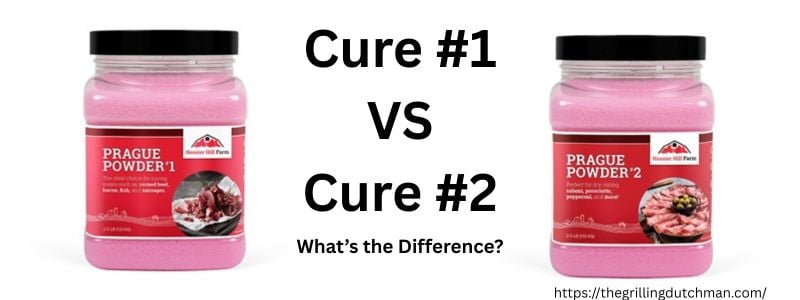
When I started making my own bacon and sausage, I quickly ran into curing salt. And that’s when the big question pops up: what’s the difference between curing salt #1 and #2?
KeyTakeaway
Curing Salt #1 (Prague Powder #1) has only salt and sodium nitrite and is used for short cures and cooking meats like bacon, corned beef, and sausages. Curing Salt #2 (Prague Powder #2) adds sodium nitrate, which slowly turns into nitrite for long, dry cures of uncooked meats like salami and prosciutto.
Eddie’s Tip! Using the wrong type can be dangerous, allowing bacteria to grow or leaving leftover nitrates in the meat.
Now let’s break that down so you know exactly which one to grab for your next project.
What Is Curing Salt?
Curing salt is not the same as table salt. It’s a mix of regular salt and special ingredients that prevent dangerous bacteria, like botulism, from growing while your meat cures.
- Curing Salt #1 contains salt and sodium nitrite.
- Curing Salt #2 contains salt, sodium nitrite, and sodium nitrate.
The difference between nitrite and nitrate is important. Nitrites work quickly but don’t last long. Nitrates break down slowly into nitrites over time, which is why they’re used in long cures.
Eddie’s Tip! For both cure #1 and cure #2, I always double-check the amounts with a trusted curing calculator It makes sure your meat stays safe and tastes great
Curing Salt #1
Also called Prague Powder #1 or Pink Curing Salt #1, this cure is made for short projects.
- Best for cures that last a few hours up to a few days
- Works in foods that will be cooked, smoked, or baked
- Common uses:
- Homemade bacon
- Smoked sausage
- Ham that will be cooked
If you’re making bacon at home, you’ll be using cure #1. Check out my step-by-step guide to making bacon for more details.
Eddie’s Tip! When using cure #1 for bacon or fresh sausage, always weigh your meat and salt carefully. Too much or too little can affect both safety and flavor.
Curing Salt #2
Also known as Prague Powder #2, this one is designed for the long haul.
- Best for cures that last weeks or even months
- Perfect for meats that will be air-dried and not cooked
- Contains nitrates, which slowly release nitrites during curing
- Common uses:
- Salami
- Pepperoni
- Prosciutto
- Dry-cured sausages
Eddie’s Tip! Cure #2 is for long, dry-cured meats. Make sure you have a safe, cool, and humid environment — patience is key for great results
If you’re making old-world style dry sausage, you’ll be reaching for cure #2. See my beginner’s guide to making sausage for more info.
Quick Comparison Table
| Feature | Curing Salt #1 | Curing Salt #2 |
|---|---|---|
| Also Called | Prague Powder #1 | Prague Powder #2 |
| Main Ingredients | Salt + Sodium Nitrite | Salt + Sodium Nitrite + Sodium Nitrate |
| Cure Time | Hours to a few days | Weeks to months |
| Used For | Bacon, ham, smoked sausage | Salami, prosciutto, dry-cured sausage |
| Cooked After Cure? | Yes | Usually No |
Eddie’s Tip! If you’re ever unsure which cure to use, stick with #1 for cooked meats and #2 only for dry-aged products.
Safety First
Curing salts are powerful and should never be used like table salt.
- Always measure carefully with a scale.
- Follow your recipe’s directions.
- Don’t swap #1 and #2 — they are not interchangeable.
Too much curing salt can make food unsafe. Too little and bacteria can grow. Play it safe.
For bacon, it’s always best to follow a trusted recipe. My guide on how to cure and smoke bacon at home walks you through it step by step.
Eddie’s Tip! Always use a digital scale for curing salts — guessing can be dangerous. Following recipes precisely keeps your meat safe and tasty.
Curing Salt #1 vs #2 – My Experience
In my own cooking, I use cure #1 the most. Bacon, ham, and fresh sausages are part of my regular cooking, and that’s where it works the best. When I help friends try their first homemade bacon, I always start them with cure #1 because it’s simple, fast, and tasty.
I’ve used cure #2 for dry sausages, but that takes patience and the right setup. It’s rewarding if you love traditional flavors, but not where I recommend beginners start.
Once you’re comfortable with bacon and ham, moving into dry sausages is the next step. My article on how to prepare homemade sausage from scratch can help you get started.
If you’re just getting into curing and making bacon or sausage using curing salt #1. Once you’re comfortable, then explore the longer cures you need for charcutery with cure #2.
Eddie van Aken
Eddie van Aken brings years of experience from running a full-service restaurant, where he honed his skills with all types of kitchen equipment. His expertise extends to mastering the art of outdoor cooking, utilizing the right recipes to enhance flavors on grills and smokers. Eddie’s in-depth knowledge allows him to provide comprehensive grill reviews and valuable outdoor cooking tips, helping enthusiasts make the most of their grilling adventures. You can read more on the About page for Eddie van Aken
